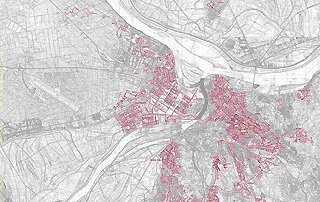The deliverable D.2.1 “Low temperature concepts” defines the RELaTED low temperature concepts, considering potentialities and limitations imposed by distributed energy sources (DER), low temperature (LT) and ultra-low temperature (ULT) distribution systems as well as heat and domestic hot water demand.

Overview Beoelektrane DH network Belgrade.
RELaTED project deploys a decentralized, Ultra-Low Temperature (ULT) DH network concept, which allows for the incorporation of low-grade heat sources with minimal constraints, larger shares of renewable energy sources (RES) and distributed heat sources. ULT DH reduces operational costs due to fewer heat losses, better energy performance of heat generation plants and extensive use of de-carbonized energy sources at low marginal costs.
In RELaTED Task 2.1 the low temperature district heating concept is being defined, and some of the possibilities for integrating distributed energy recourses into a low temperature district heating network are being analysed and compared.
The low temperature concept is defined by temperature levels, the possibilities to improve renewable share/CO2-emission with a more diversified production with distributed heat sources, the ability to expand the district heating networks to new districts without changing the existing network and optimize the performance of the network and thereby operate more feasibly.
Different technology options and barriers to achieve low temperature networks are being discussed on both building, network, and energy source level. On building level, the barriers are about heat emitters and domestic hot water production. On network level optimizing the pipe system length, dimension and insulation level are addressed. Some of the energy sources options for distributed heat sources in ultra-low district heating systems (ULT DH) are discussed.
For each of the four demo sites the development activities within RELaTED are presented and thoughts about how the RELaTED concept can be implemented and evolve on a longer term are shared.
The collected data about the networks in the demo sites are analysed and the heat loss on subnet level are calculated.
D.2.1 “Low temperature concepts” report contains a definition of ultra-low temperature, distributed energy sources, heating and cooling demand, hot water systems and demand, DH network systems and primary energy, CO2 and renewable energy factors.
Selected development activities for distributed energy sources and temperature levels are analysed and the calculated cases for each site are compared on the parameters: share of distributed energy consumption, total energy consumption, share of solar energy and waste, performance indicator factors for primary energy, CO2, and renewable energy ratio.
These results will be used in the succeeding work packages of RELaTED to investigate further the architecture of the ULT concept (WP2), design and adaption of subsystems to facilitate the use of distributed energy resources (WP3), analyse the economic feasibility and business case (WP4) and prepare and conduct demonstrations (WP5), of the RELaTED project.
D.2.1 “Low temperature concepts” report contains a definition of ultra-low temperature, distributed energy sources, heating and cooling demand, hot water systems and demand, DH network systems and primary energy, CO2 and renewable energy factors.
This document also describes the basic ULT-concept of RELaTED and the benefits, the framework for the concept, technical options for ULT on building, sub-net and system level, and the general preconditions of implementing the ULT concept at the four demo sites of RELaTED.
Also contains a possible short and long-term implementation of the ULT concept at each demo site, analysing of building systems, distribution networks and energy resources and overall concept evaluation for each demo site.
